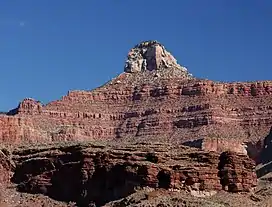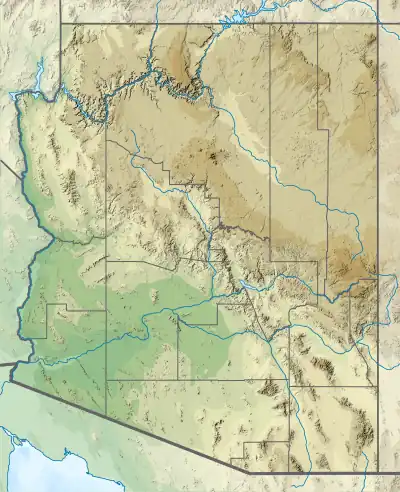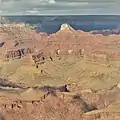Buddha Temple (Grand Canyon)
Buddha Temple is a 7,212-foot-elevation (2,198-meter) summit located in the Grand Canyon, in Coconino County of northern Arizona, in the Southwestern United States.[3] It is situated 6.5 miles (10.5 km) due north of the Mather Point overlook on the canyon's South Rim, and four miles southwest of the North Rim's Bright Angel Point. Topographic relief is significant as it rises over 3,800 feet (1,200 meters) in two miles above Bright Angel Canyon to the east, and 3,000 feet in less than one mile above Haunted Canyon to the immediate west. Its neighbors include Manu Temple 1.5 miles (2.4 km) to the northeast, Isis Temple 2.3 miles to the southwest, Zoroaster Temple 3.8 miles to the southeast, and Deva Temple, 3.5 miles to the east. Buddha Temple was named by Henry Gannett, a geographer for Clarence Dutton, in following Dutton's practice of naming features in the Grand Canyon after mythological deities, in this case Buddha.[4][5] This geographical feature's name was officially adopted in 1906 by the U.S. Board on Geographic Names.[3] The first ascent of this butte was made in 1973 by Bruce Grubbs, Chauncey Parker, and Mark Brown via the Northwest Arete.[6] According to the Köppen climate classification system, Buddha Temple is located in a Cold semi-arid climate zone.[7]
| Buddha Temple | |
|---|---|
 South aspect | |
| Highest point | |
| Elevation | 7,212 ft (2,198 m)[1] |
| Prominence | 766 ft (233 m)[1] |
| Parent peak | The Colonnade (7,602 ft)[2] |
| Isolation | 1.46 mi (2.35 km)[2] |
| Coordinates | 36°09′10″N 112°05′55″W[3] |
| Geography | |
 Buddha Temple  Buddha Temple | |
| Location | Grand Canyon National Park Coconino County, Arizona, US |
| Parent range | Kaibab Plateau[1] Colorado Plateau |
| Topo map | USGS Bright Angel Point |
| Geology | |
| Type of rock | limestone, sandstone, mudstone |
| Climbing | |
| First ascent | 1973 |
| Easiest route | class 5.4 climbing[2] |
Geology
The summit of Buddha Temple is composed of Kaibab Limestone caprock overlaying cream-colored, cliff-forming, Permian Coconino Sandstone.[8] The sandstone, which is the third-youngest of the strata in the Grand Canyon, was deposited 265 million years ago as sand dunes. Below the Coconino Sandstone is slope-forming, Permian Hermit Formation, which in turn overlays the Pennsylvanian-Permian Supai Group. Further down are strata of Mississippian Redwall Limestone, Cambrian Tonto Group, and finally Proterozoic Unkar Group at creek level and Granite Gorge.[9] Precipitation runoff from Buddha Temple drains south into the Colorado River via Bright Angel Creek on its east side, and Phantom Creek on the west side.
Gallery
See also
References
- "Buddha Temple, Arizona". Peakbagger.com. Retrieved 2020-12-25.
- "Buddha Temple – 7,212' AZ". Lists of John. Retrieved December 25, 2020.
- "Buddha Temple". Geographic Names Information System. United States Geological Survey, United States Department of the Interior. Retrieved 2020-12-25.
- Randy Moore and Kara Felicia Witt, The Grand Canyon: An Encyclopedia of Geography, History, and Culture, 2018, ABC-CLIO Publisher, pp. 151, 170.
- N.H. Darton, Story of the Grand Canyon of Arizona, 1917, p. 77.
- Todd R. Berger, Reflections of Grand Canyon Historians: Ideas, Arguments and First-Person Accounts, 2nd edition, 2008, Grand Canyon Association Publisher, ISBN 978-1934656006
- Peel, M. C.; Finlayson, B. L.; McMahon, T. A. (2007). "Updated world map of the Köppen−Geiger climate classification". Hydrol. Earth Syst. Sci. 11. ISSN 1027-5606.
- N.H. Darton, Story of the Grand Canyon of Arizona, 1917, pp. 32, 37, 45.
- William Kenneth Hamblin, Anatomy of the Grand Canyon: Panoramas of the Canyon's Geology, 2008, Grand Canyon Association Publisher, ISBN 9781934656013.
External links
- Weather forecast: National Weather Service
- Buddha Temple Rock Climbing, mountainproject.com


.jpg.webp)


.jpg.webp)


